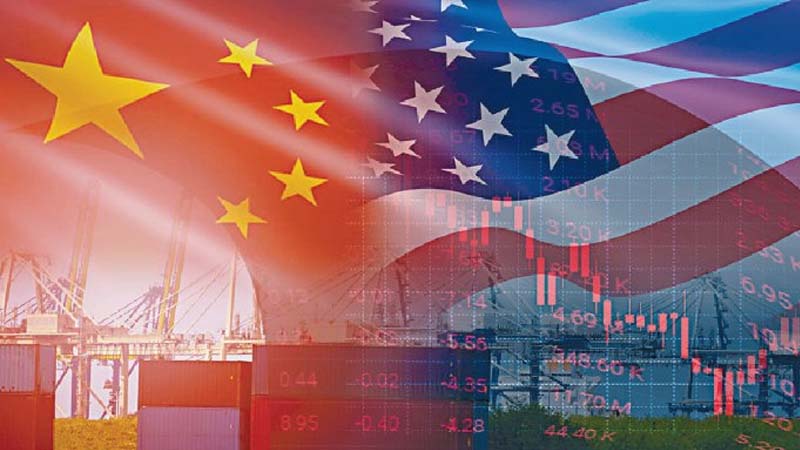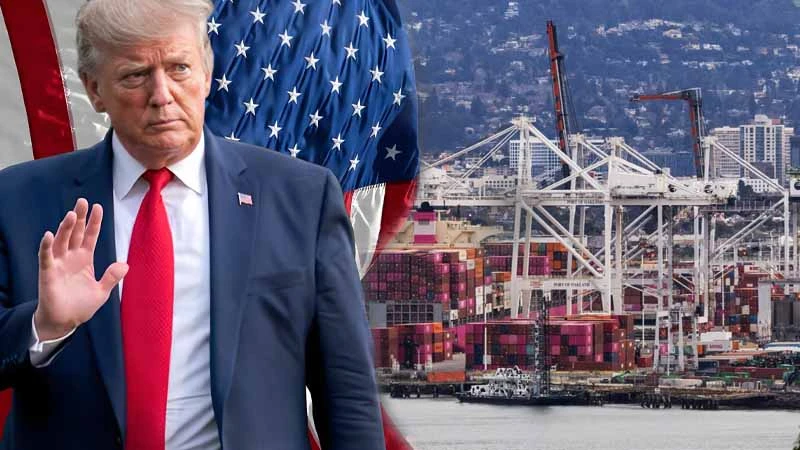Investment insights from the escalating US-China trade war: How tariff policies are reshaping the global trade landscape
When the US government announced a comprehensive 10% tariff on Chinese exports to the US, and for the first time included Hong Kong in the scope of taxation, global financial markets immediately rippled. This policy not only touched the sensitive nerve of US-China relations but also directly impacted Hong Kong’s core function as an international trade hub. For investors in the forex and commodities markets, understanding the underlying logic of this trade conflict will be the key to grasping the patterns of market volatility in 2025.
Dual Effects of Tariff Policy: From Trade Barriers to Currency Volatility
Following the implementation of the latest tariff policy, the weighted average tariff rate on Hong Kong exports to the US will surge from 1.4% to 11.4% (refer the United States International Trade Commission USITC tariff database for details). This means an additional cost of USD 114 million for every USD 1 billion in trade volume. This move has already triggered a chain reaction—according to data from the Hong Kong Trade Development Council, over 60% of re-export trading firms are reassessing their supply chain arrangements, with some manufacturers beginning to shift production bases to Southeast Asia.
Tariff Impact Comparison Table:
| Indicator | Before Policy Implementation | After Policy Implementation | Change Range |
| Total Value of Hong Kong Exports to US | USD 4.1 billion | Estimated USD 3.7 billion | -9.8% |
| Average Tariff Cost Rate | 1.4% | 11.4% | +714% |
| Cross-border E-commerce Logistics Cost | 12-15% | 18-22% | +50% |
| HKD Exchange Rate Fluctuation Range | ±0.3% | ±0.8% | +167% |
supply chain restructuring is driving up demand for Southeast Asian currencies, with forward contract trading volume for the New Taiwan dollar and Vietnamese dong increasing by 23% year-on-year; second, the total balance of the Hong Kong banking system has declined for three consecutive weeks, reflecting tightening capital liquidity, which may widen the interest rate spread between the Hong Kong dollar and the US dollar.
Investment Opportunities Arising from the Transformation of Hong Kong’s Role as a Trade Hub
Although the short-term impact of tariff policies is evident, Hong Kong’s unique institutional advantages are giving rise to new market opportunities. We have identified three major transformation trends:
Surging Demand for Cross-Border Financial Services
As companies require more sophisticated currency hedging solutions, Hong Kong’s forex derivatives market saw a 17% increase in open interest within two weeks of the policy announcement, with RMB option trading rising to 38% of the total. This presents two key opportunities for investors:
- Hedging policy risk through cross-market arbitrage
- Positioning in fintech companies offering cross-border payment solutions
Regional Trade Corridors Are Being Reshuffled
ASEAN countries’ reliance on Hong Kong for re-export trade is increasing at a rate of 2.3% per month, particularly in sectors such as electronic components and medical equipment. This is driving a noticeable divergence in related shipping indices (such as the Hong Kong Container Throughput Index) and logistics real estate REITs. Companies with warehouse networks in Southeast Asia are now trading at a valuation premium of 15–20%.
Digital Trade Infrastructure Development Accelerates
In response to rising physical trade costs, the Hong Kong Monetary Authority has recently accelerated testing of its cross-border digital currency settlement system, with 12 multinational banks already participating in the mBridge project. This transformation may reshape the liquidity structure of the forex market, and the spot rate correlation between offshore RMB (CNH) and USD/HKD warrants close attention.
Multi-Dimensional Response Strategies Amid the US-China Trade War
As the US-China trade war continues to escalate, tariff policies have evolved from simple trade barriers into key variables influencing capital market pricing. Using a tiered analysis framework, we aim to show investors how to construct a three-layered defense: managing volatility, capturing trends, and seizing structural transformation amid policy uncertainty.
First Dimension: Precision Allocation for Volatility Management
According to Bloomberg historical backtesting, during the peak of the trade war from 2018 to 2020, a portfolio combining gold and Swiss francs was able to hedge 67% of policy-driven currency volatility risks. A dynamic allocation strategy is recommended:
- Base Allocation: 15% physical gold ETFs (e.g., GLD) + 5% spot Swiss franc positions
- Extreme Scenario Upsizing: When the HIBOR–LIBOR spread exceeds 150 basis points, increase the hedge position to 25%
Hedge Asset Performance Comparison Table (Annualized Returns)
| Asset Class | Trade War Period (2018–2020) | Policy Calm Period (2021–2023) | Volatility Difference |
| Gold | +9.2% | +3.1% | 18.7 vs 12.4 |
| Swiss Franc | +6.8% | -1.2% | 9.3 vs 6.8 |
| 10-Year US Treasury | +5.1% | -2.3% | 14.2 vs 8.9 |
Second Dimension: Regional Allocation for Trend Capture
Southeast Asia’s manufacturing sector is absorbing industrial shifts at an average annual rate of 7.3%, offering investors a two-phase entry approach:
Phased Allocation Strategy
- Initial Dividend Capture: Allocate to electronic manufacturing clusters within the iShares MSCI Southeast Asia ETF (ESEA) (38% share), with a focus on Vietnam (24% weight) and Malaysia (19%)
- Industry Chain Deepening Phase: When regional export growth exceeds 8% for three consecutive months, shift to specialized funds such as the Matthews Asia Small Companies Fund (MASCX)
Risk Hedging Mechanism
Establishing a “Singapore dollar–Thai baht” currency hedge portfolio can reduce foreign exchange losses by 23% (according to Morgan Stanley’s 2023 emerging market model)
Third Dimension: Value Discovery in Structural Transformation
According to the Hong Kong Monetary Authority’s “2024 Fintech Blueprint,” digital payments and cold chain logistics will receive an average of HKD 1.2 billion in annual policy subsidies. It is recommended to focus on two types of targets:
Digital Payment Breakthroughs
- Cross-Border Settlement Platforms: Select companies with average daily transaction volume exceeding HKD 5 billion (such as ZA Bank))
- Blockchain-Based Billing Systems: Focus on technology providers directly integrated with the mBridge project
Cold Chain Logistics Value Chain
| Indicator | High-Potential Benchmark | Risk Alert Threshold |
| Southeast Asia Warehouse Share | ≥35% | ≤15% |
| Cross-Border Bonded Warehouse Utilization Rate | ≥80% | ≤50% |
| Digital Temperature Control System Penetration Rate | ≥60% | ≤30% |
Conclusion: Finding Certainty in the Reshaping of the Trade Landscape
The essence of the US-China trade war is a rebalancing of global economic leadership. For sharp-eyed investors, tariff policies are not merely threats of rising costs, but catalysts driving market repricing. It is recommended to closely monitor three key signals: the interest rate spread between Hong Kong Interbank Offered Rate (HIBOR) and US LIBOR, transaction volume trends in the Cross-Border Interbank Payment System (CIPS), and throughput data from major ASEAN ports. Only by translating trade policy into concrete market variables can structural opportunities be captured amid volatility.
Frequently Asked Questions
Q1. What Are the Tariffs Imposed by the US on China?
The US has imposed four rounds of tariffs on Chinese goods under “Section 301”. The current tariff structure (for real-time rates, it is recommended to consult the Global Trade Alert database) is as follows:
| Tariff Round | Effective Date | Covered Goods Value | Average Tariff Rate | Key Affected Industries |
| First Round | July 2018 | USD 34 billion | 25% | Industrial machinery, semiconductors |
| Second Round | August 2018 | USD 16 billion | 25% | Chemicals, electronic components |
| Third Round | September 2018 | USD 200 billion | 10%-25% | Furniture, textiles |
| Forth Round | September 2019 | USD 120 billion | 7.5%-15% | Consumer electronics, toys |
In addition, certain goods may apply for the “exemption list”. As of June 2024, the Office of the United States Trade Representative (USTR) has approved temporary exemptions for 352 products, including medical devices and bicycle components.
Q2. What Is Included in the US Tariff List in China?
The tariff list covers multiple key industries, primarily categorized as follows:
1.Technology and Industrial Products
- Semiconductor manufacturing equipment (HS 8486): 25% tariff
- Lithium batteries (HS 8507): 7.5% tariff
- Industrial robots (HS 8428): 15% tariff
2.Consumer Goods and Daily Necessities
- Smartphones (HS 8517): 15% tariff
- Laptops (HS 8471): 7.5% tariff
- Home appliances (HS 8415): 25% tariff
3.Raw Materials and Semi-Finished Products
- Steel and aluminum products (HS 7210–7229): 25% tariff (additional global tariff under Section 232)
- Rare earth metals (HS 2805): 15% tariff
Data Impact: Goods affected by tariffs account for 66% of total US-China trade volume according to a detailed (report by the US-China Business Council). US imports from China dropped from USD 539.5 billion in 2018 to USD 427 billion in 2023.
Q3. Is the US-China Trade War Over?
The US-China trade war has not officially ended from a legal standpoint, but the nature of the conflict has shifted toward technology controls and supply chain restructuring (for the latest data on industrial relocation, see the World Bank’s annual report on “Global Value Chain Restructuring”).
Supply Chain Adjustment: Vietnam’s exports to the US rose by 217% (2018–2023). Mexico has replaced China as the US’s largest trading partner. China is accelerating its “domestic circulation” strategy, with its export share to ASEAN rising to 15.8% in 2023.
Future Scenarios:If tariffs escalate, Trump has proposed a unified 60% tariff, which could result in a global GDP loss of 0.8%–1.2%. On the other hand, if partial easing occurs, key sectors such as semiconductors may be granted tariff exemptions, potentially reducing US consumer goods prices by 12%–18%.
Related articles
-
Since 2025, global financial markets have continued to focus on the monetary policy trends of the US Federal Reserve (Fed) and movements in the US Dollar Index. As a barometer of the international market, the performance of the US Dollar Index (DXY) directly affects asset prices and capital flows in...2025 年 3 月 18 日
-
2024 Q4 US Nasdaq Index plunged 3.6%, while the Hang Seng Tech Index fell 4.2% simultaneously, highlighting that the linkage between the two markets has deepened to the level of capital flows. Facing the Federal Reserve’s policy swings, the tech industry’s cyclical shifts, and rising geopolitical risks, Hong Kong stocks...2025 年 2 月 21 日
-
In February 2025, Donald Trump's 25% tariff on imported cars triggered an instant earthquake in the global supply chain. This trade policy, which has been labelled “America First 2.0", has not only forced multinational car companies to urgently reorganise production, it has also pushed the price of precious metals past...2025 年 2 月 21 日













